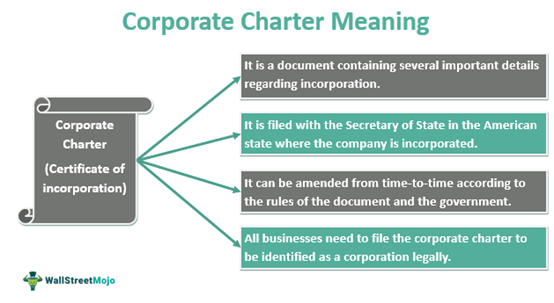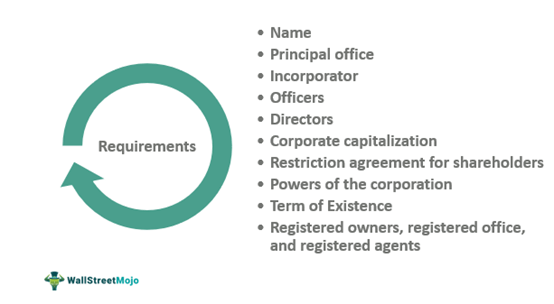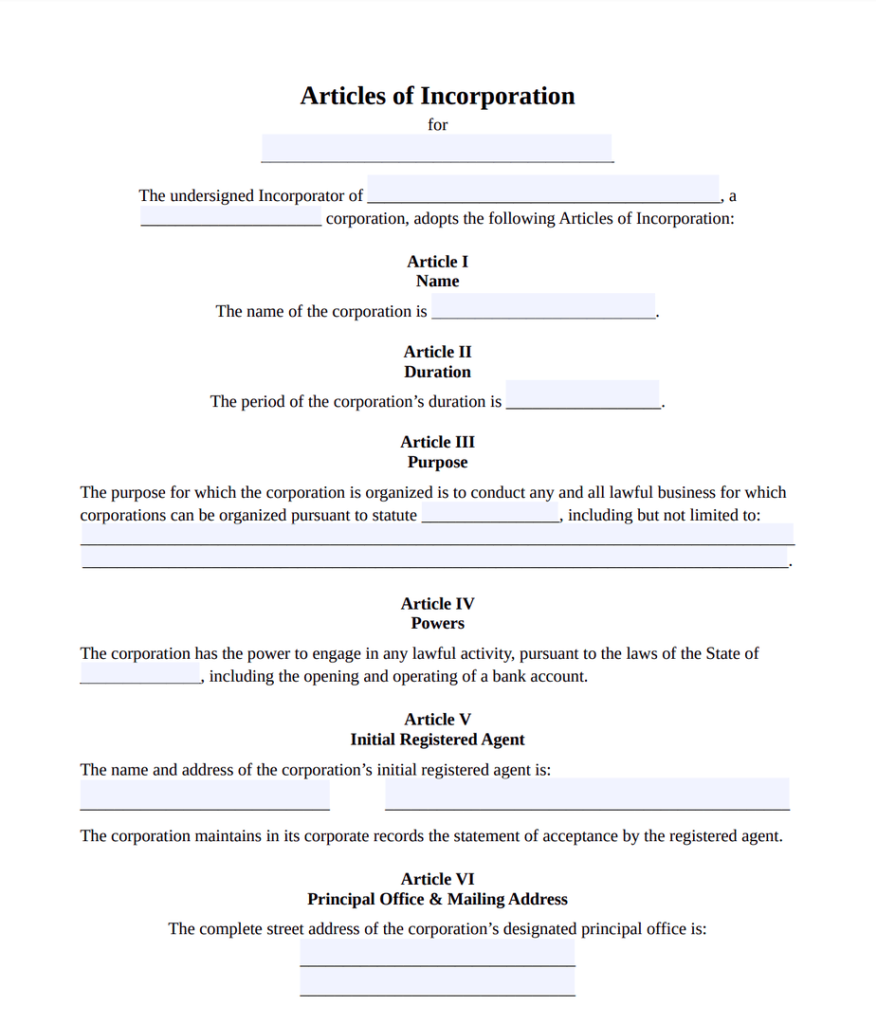What Is A Corporate Charter?
A corporate charter is the governing document of a corporation. It is also known as a “certificate of incorporation” or “articles of incorporation.” The document informs the government of the company’s existence. It contains details about the name of the company, its board of directors, the shareholding capacity, etc., among other things.

You are free to use this image on your website, templates, etc, Please provide us with an attribution linkHow to Provide Attribution?Article Link to be Hyperlinked
For eg:
Source: Corporate Charter (wallstreetmojo.com)
The law demands the filing of a corporate charter for the incorporation of a business. It provides the company with a legal entity status separate from its owners. The charter helps in raising capital from the public and tax management. In addition, it improves the overall credibility of a business in the marketplace and the confidence of creditors.
Table of contents
Key Takeaways
- A corporate charter is a document that is legally required for a business to be identified as a corporation.
- Corporate charters serve to represent the contracts that exist between corporations and their stockholders. It outlines the rights of stockholders and the powers of the corporation’s officers.
- An incorporator must draft and submit documents to the secretary of state in the state where the business will be incorporated. The name, purpose of the corporation, and initial capital structure, such as the number and classes of shares, must be listed in the charter.
- They specify shareholders’ voting rights, rules, and regulations, the election of directors, and the approval process and procedure for mergers or sales of assets, among other things.
Corporate Charter Explained
The corporate charter definition suggests a formal document that contains descriptions of an organization’s rights, aims, principles and the people who are part of it. A corporate charter is filed with the Secretary of State in the American state where the business is incorporated. It is a document that gives life to the corporation, embodying within it the particulars that make up the company.
Generally, a basic corporate charter contains details stating the name of the company and the board of directors, shareholders, etc. In addition, it includes the address of the company, other offices, if any, and the residency details of the directors. The purpose of creating the company and the business it looks forward to should also be registered. Furthermore, the corporate charter should present information on the capital it holds and shares, its voting rights, and the removal and addition of members.
The framework will help gain tax benefits on expenses, access funds by selling stocks, and transfer ownership, all in addition to the shareholders’ limited responsibility. The charter also acts as a guide for the organization by outlining the corporation’s objectives and offering a general idea of how to achieve them.
Financial Modeling & Valuation Courses Bundle (25+ Hours Video Series)
–>> If you want to learn Financial Modeling & Valuation professionally , then do check this Financial Modeling & Valuation Course Bundle (25+ hours of video tutorials with step by step McDonald’s Financial Model). Unlock the art of financial modeling and valuation with a comprehensive course covering McDonald’s forecast methodologies, advanced valuation techniques, and financial statements.
Requirements
Given below are a few of the details a basic corporate charter contains:

You are free to use this image on your website, templates, etc, Please provide us with an attribution linkHow to Provide Attribution?Article Link to be Hyperlinked
For eg:
Source: Corporate Charter (wallstreetmojo.com)
#1 – Name
The name of the prospective business should be present here, under the suffix of “Inc.” or “Incorporated” as a corporate. This shall be distinct from any existing company and comply with national laws adhering to the common grounds.
#2 – Purpose of the corporation
The charter must address the reason for the formation of the business, which should be by state laws. In addition, the business should provide details about its plans, aspirations, and products or services it intends to sell.
#3 – Principal office
The primary address of the business must be provided in this space. The address will subsequently be used for official communication.
#4 – Incorporator
The details of the person termed as the “incorporation,” along with the address of their official residence, must be present in the charter.
#5 – Officers
The names and designations of people inside the business, such as presidents, treasurers, etc., should be there. The mailing addresses of the offices shall be the same as the corporation’s principal office.
#6 – Directors
The charter must contain the list of Individuals designated as directors. Their mailing addresses must also be the same as the corporation’s principal office.
#7 – Corporate Capitalization
The charter should also include the maximum number of common shares, their nature, and the voting rights they carry with them. In the event of dissolution, the amount of compensation to be received and the order in which it will be given away, including share specifics, whether the shares are convertible, and restrictions governing purchases and sales of these shares, should be mentioned. The power of the board of directors to classify or reclassify unissued stocks or their redemption is also a requirement.
#8 – Restriction agreement for shareholders
The Shareholders Restrictive Agreement contains numerous limitations on the rights of the corporation’s shareholders and the transferability of its stock shares. Accordingly, if any, a copy of the shareholders’ restrictive agreement should be maintained at the corporation’s principal office.
#9 – Powers of the corporation
The corporation shall have the same rights and authority as an individual to conduct its business operations, subject to any limitations or restrictions imposed by applicable law or the Articles of Incorporation.
#10 – Term of Existence
The terms of existence, usually perpetual, are necessary for a charter.
#11 – Registered owners, registered office, and registered agents
The corporation’s owner shall be the person whose name the shares or rights are registered as per the corporation’s books. The registered office and registered agent’s address shall be the same. A registered agent is a chosen representative whose task is to receive and manage legal documents on behalf of the corporation.
The business can amend the charter per the law permitting as per the state and as mentioned in the articles.
Examples
Let us understand the concept with a simple basic corporate charter example:
Daniel from Iowa wants to form a company that manufactures baby clothes. Below are a few details he has to fill in the corporate charter document for incorporation.
#1 – Name
Suppose he wants to name it “bamboo” collections; the same shall be in the column (along with the nature of the business- partnership or sole proprietorship etc.).
#2 – Purpose of the corporation
The purpose here will be to enter into a business that sells baby clothes in adherence to the state laws.
#3 – Principal office
He plans to start a business in the state. Therefore, he fills the address of the registered office in Iowa here.
#4 – Incorporator
Daniel is the incorporator.
#5 – Officers
Daniel is the president, so he adds his name here; suppose his wife Daisy is the treasurer. Then her name will be under the designation of treasurer.
#6 – Directors
If the company has directors, their names must be present here.
#7 – Corporate capitalization
The amount of capital invested, say $10,000, is the initial investment for the business. Then, suppose multiple people have invested their money in the company. Their names, along with the contribution under the name of shareholders, shall be given.
Similarly, other features such as the duration and whether or not the venture will be closed after a particular point shall be motioned. Details such as the number of shares and their type, whether they carry preferential rights, conversion rules they are subjected to, etc., shall be mentioned along with the rest of the requirements.
Template
Below is the corporate charter sample provided for reference:

Corporate Charter Vs Corporate Bylaws
While a corporate charter is a legal document that gives an entity legal recognition as an organization, corporate bylaws are yet another legal document that specifies the internal structure of a firm along with the guidelines that need to be followed.
The other differences between the two are as follows:
- The former is written by an attorney, who may or may not necessarily be a member of the board of directors. On the contrary, bylaws for a corporation are prepared and written by the board of directors.
- The name and location of the firm are important components of the articles of incorporation or the charter of the corporation. The components of the bylaws are determined per the requirements of the firm and its nature.
- While the purpose of the company is defined under the charter, the shareholders’ rights and limitations to vote are specified in the bylaws of the company.
Though there are multiple differences between the two, the formation of the corporation remains incomplete until the bylaws are prepared and adopted by an entity.
Frequently Asked Questions (FAQs)
The corporate Charter Number, which consists of 8 digits plus one of the provided codes, is each entity’s distinctive and permanent identification number. Different codes represent different entities, such as D, B, RR, CP, or I-For Domestic Business Corporations, F-For Foreign Business Corporations, and ND-For Domestic Nonprofit Corporations.
It showcases the formal, individual, and legal identity of the corporation. It is the foundation step of incorporating a business. In addition, it reveals important information about the vital components of the entity, such as the directors, shareholders, capital contribution, etc.
A corporate charter is filed with the Secretary of State of the U.S., where the business is established.
It can be written using a corporate charter template by filling in the required details, or one can seek legal help. However, the use of a corporate charter template should be done with caution.
Recommended Articles
This has been a guide to What is Corporate Charter and its definition. Here, we explain its requirements along with an Example. You may also find some useful articles here:


Leave a Reply